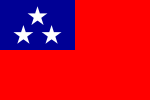Taiwanese People's Party
|
Taiwanese People's Party
臺灣民眾黨 |
|
|---|---|
| Founded | 10 July 1927 |
| Dissolved | August 1931 |
| Headquarters | Taihoku, Japanese Taiwan |
| Ideology |
Liberalism Social liberalism Liberal nationalism |
| Political position | Centre-left |
| Party flag | |
 |
|
The Taiwanese People's Party (Chinese: 臺灣民眾黨; pinyin: Taiwan Minzhongdang; Pe̍h-ōe-jī: Tâi-oân Bîn-chiòng Tóng; Japanese pronunciation: Taiwan-minshutō), founded 1927, was nominally Taiwan's first political party, preceding the founding of the Taiwanese Communist Party by nine months. Initially a party with members holding moderate and conservative views, by the time of its banning, on 18 February 1931, it had become a solidly leftist, workers-oriented party. In a political atmosphere increasingly dominated by the rise of Japanese fascism, the party never participated in electoral politics.
The party grew out of the conflict within the Taiwanese Cultural Association. By the late 1920s that organization had become largely socialist-dominated. A group of its founders met during the first half of 1927 to plan an alternative, more moderate organization. After several of their proposals had been rejected by the Japanese authorities, they finally settled on "Taiwanese People's Party" and a much diluted, vaguely worded party program. Specifically the new party officially disavowed any ambition to promote "national struggle" and declared its intention to use legal means to "affirm democratic politics", establish "reasonable economic organization" and reform "defects in the social institutions". In terms of policy it advocated the rights of Taiwanese to publish newspapers, the need to teach Taiwanese in public schools, abolition of a system of informers known as "Baojia Zhidu", removal of the need for passports when travelling to mainland China, and reform of the farmers' associations and government monopolies.
The party grew quickly; by the end of 1927 it had 15 branches and 456 members, among them many prominent elites, including landowners, lawyers and doctors. However, the vague party charter soon presented problems: on the one hand the charter had apparently managed to placate the wary authorities; on the other, the vague wording had the effect of hiding away some of the divisive ideological differences among the most powerful players. During the party's short existence its internal politics was dominated by the struggle between the left-wing, led by Chiang Wei-shui, and the right-wing, represented by Peng Hua-ying (), to define the party's core values, particularly its position on "the class question". Whereas Chiang's faction sought to define the party as representing the interests of workers and peasants, Peng's faction took the moderate position of "working to improve their quality of life". After Chiang set up the Taiwanese Workers' Alliance as a party affiliate in February 1928, Peng resigned in protest. By early 1930 a number of conservatives had left the party to form the Taiwanese Alliance for Home Rule.
...
Wikipedia
